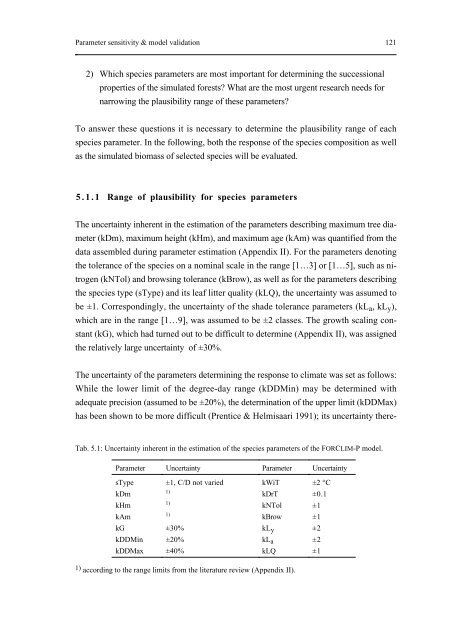On the Ecology of Mountainous Forests in a Changing Climate: A ...
On the Ecology of Mountainous Forests in a Changing Climate: A ...
On the Ecology of Mountainous Forests in a Changing Climate: A ...
Create successful ePaper yourself
Turn your PDF publications into a flip-book with our unique Google optimized e-Paper software.
Parameter sensitivity & model validation 121<br />
2) Which species parameters are most important for determ<strong>in</strong><strong>in</strong>g <strong>the</strong> successional<br />
properties <strong>of</strong> <strong>the</strong> simulated forests? What are <strong>the</strong> most urgent research needs for<br />
narrow<strong>in</strong>g <strong>the</strong> plausibility range <strong>of</strong> <strong>the</strong>se parameters?<br />
To answer <strong>the</strong>se questions it is necessary to determ<strong>in</strong>e <strong>the</strong> plausibility range <strong>of</strong> each<br />
species parameter. In <strong>the</strong> follow<strong>in</strong>g, both <strong>the</strong> response <strong>of</strong> <strong>the</strong> species composition as well<br />
as <strong>the</strong> simulated biomass <strong>of</strong> selected species will be evaluated.<br />
5.1.1 Range <strong>of</strong> plausibility for species parameters<br />
The uncerta<strong>in</strong>ty <strong>in</strong>herent <strong>in</strong> <strong>the</strong> estimation <strong>of</strong> <strong>the</strong> parameters describ<strong>in</strong>g maximum tree diameter<br />
(kDm), maximum height (kHm), and maximum age (kAm) was quantified from <strong>the</strong><br />
data assembled dur<strong>in</strong>g parameter estimation (Appendix II). For <strong>the</strong> parameters denot<strong>in</strong>g<br />
<strong>the</strong> tolerance <strong>of</strong> <strong>the</strong> species on a nom<strong>in</strong>al scale <strong>in</strong> <strong>the</strong> range [1…3] or [1…5], such as nitrogen<br />
(kNTol) and brows<strong>in</strong>g tolerance (kBrow), as well as for <strong>the</strong> parameters describ<strong>in</strong>g<br />
<strong>the</strong> species type (sType) and its leaf litter quality (kLQ), <strong>the</strong> uncerta<strong>in</strong>ty was assumed to<br />
be ±1. Correspond<strong>in</strong>gly, <strong>the</strong> uncerta<strong>in</strong>ty <strong>of</strong> <strong>the</strong> shade tolerance parameters (kL a , kL y ),<br />
which are <strong>in</strong> <strong>the</strong> range [1…9], was assumed to be ±2 classes. The growth scal<strong>in</strong>g constant<br />
(kG), which had turned out to be difficult to determ<strong>in</strong>e (Appendix II), was assigned<br />
<strong>the</strong> relatively large uncerta<strong>in</strong>ty <strong>of</strong> ±30%.<br />
The uncerta<strong>in</strong>ty <strong>of</strong> <strong>the</strong> parameters determ<strong>in</strong><strong>in</strong>g <strong>the</strong> response to climate was set as follows:<br />
While <strong>the</strong> lower limit <strong>of</strong> <strong>the</strong> degree-day range (kDDM<strong>in</strong>) may be determ<strong>in</strong>ed with<br />
adequate precision (assumed to be ±20%), <strong>the</strong> determ<strong>in</strong>ation <strong>of</strong> <strong>the</strong> upper limit (kDDMax)<br />
has been shown to be more difficult (Prentice & Helmisaari 1991); its uncerta<strong>in</strong>ty <strong>the</strong>re-<br />
Tab. 5.1: Uncerta<strong>in</strong>ty <strong>in</strong>herent <strong>in</strong> <strong>the</strong> estimation <strong>of</strong> <strong>the</strong> species parameters <strong>of</strong> <strong>the</strong> FORCLIM-P model.<br />
Parameter Uncerta<strong>in</strong>ty Parameter Uncerta<strong>in</strong>ty<br />
sType ±1, C/D not varied kWiT ±2 °C<br />
kDm<br />
1)<br />
kDrT ±0.1<br />
kHm<br />
1)<br />
kNTol ±1<br />
kAm<br />
1)<br />
kBrow ±1<br />
kG ±30% kL y ±2<br />
kDDM<strong>in</strong> ±20% kL a ±2<br />
kDDMax ±40% kLQ ±1<br />
1) accord<strong>in</strong>g to <strong>the</strong> range limits from <strong>the</strong> literature review (Appendix II).















